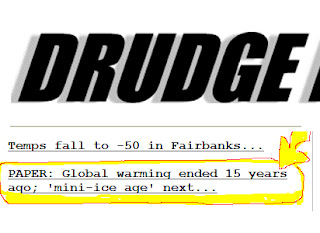 |
| Greenland photograph J E Waider via Colossal |
Getting to this predictive clarity did not happen overnight. The stages of knowledge are visible in the step-by-step understanding of the Arctic melt. Go back forty years: when reviewing the technical literature from 1965 to 1979, T. C. Peterson (2008) counted seven predictions of global cooling and forty-two papers that predicted global warming, with a majority expecting higher temperatures through rising CO2 concentrations. A majority vote is not a consensus, and so the 1975 National Research Council Report played it safe:
We do not have a good quantitative understanding of our climate machine ... it does not seem possible to predict climate.In the 1970s, the anthropogenic fate of the planet was still in doubt. Too little was known about the future of the Arctic to make any clear forecasts. This changed with the FAR or First Assessment Report, titled Climate Change: the IPCC Scientific Assessment, eds. J. T. Houghton et al. During the 1980s, the 1970s majority had hardened into a consensus. The FAR, published in 1990 by Cambridge, begins as follows (p. xi):
We are certain of the following: there is a natural greenhouse effect which already keeps the Earth warmer than it would otherwise be. Emissions resulting from human activities ... will enhance the greenhouse effect, resulting on average in additional warming of the Earth's surface.Experts understood the etiology but knew the consequences only in outline. On the Arctic there was nothing concrete except the prediction that (p. xxiii),
Surface air will warm faster over land than over oceans, and a minimum of warming will occur around Antarctica and in the northern North Atlantic region.This turned out to be two thirds right: yes, there has been more warming over land than over water, and yes again, there hasn't been much warming in Antarctica, relatively speaking; but no, the northern North Atlantic region--the Arctic--has warmed up way faster than any other place on the planet. There had not been a "minimum of warming" up north. Rather, what happened since then, compared to other regions, has been a maximum of warming. Five years later, at any rate, the predictions sharpened again a notch. The authors of the SAR or Climate Change 1995: IPCC Second Assessment Report state on p. 5-6 (section 2.10),
All model simulations ... show ... a maximum surface warming in high northern latitudes in winter, little surface warming over the Arctic in summer; an enhanced global mean hydrological cycle, and increased precipitation and soil moisture in high latitudes in winter.So the difference between winter and summer warming in the Arctic came into view then, but not yet the fact that even the Arctic summer temperatures would see surreal heat spikes. On p. 30 (section 'cryosphere'), the SAR authors write, "Models project that between one-third and one-half of existing mountain glacier mass could disappear over the next 100 years" and "Reduced sea-ice extent and thickness ... may increase navigability in the Arctic Ocean." Knowledge had evolved to the forecast that it will get warmer in the Arctic, sea ice will thin, and glaciers will shrink. Precisely when this would play out was still unclear.
In the TAR, the Climate Change 2001: IPCC Third Assessment Report, more details emerged. In the "Technical Summary of the Working Group I report" in Climate Change 2001: The Scientific Basis, J. T. Houghton, Y. Ding et al, eds. (Cambridge 2001), we find the following statement (p. 73-74, section F.8):
Glaciers and ice caps will continue their widespread retreat during the 21st century and Northern Hemisphere snow cover and sea ice are projected to decrease further ... The Antarctic ice sheet is likely to gain mass because of greater precipitation, while the Greenland ice sheet is likely to lose mass because the increase in runoff will exceed the precipitation increase.This is almost the same as in the SAR, but with two differences: spatially, experts could now differentiate among sections within the polar regions (Greenland in the Arctic; on p. 74 follows a discussion on the future of the West Antarctic ice sheet in Antarctica), and temporally, the changes were now predicted to unfold in the next hundred years. Half a decade later, in the AR4, the IPCC Fourth Assessment Report: Climate Change 2007, the fate of the Arctic sea ice at last came into view. The Climate Change 2007: Synthesis Report, R. K. Pachauri and A. Reisinger, eds., includes the following statement (p. 46, section 3.2.2.):
The "latter part" of this century would be sometime between 2050 and 2100; by 2007, the specter of a complete polar summer melt well inside this century began to loom. Again fast forward six years, and compare this to the leaked draft of AR5, the "Technical Summary" (99 pp.) of the IPCC WGI [Working Group 1] Fifth Assessment Report: Climate Change 2013 The Physical Science Basis, to be published September 2013. On p. 42 (section 5.3.1.6), the accelerating melt is in plain view:
Unless the IPCC folks revise the draft again (which is unlikely given the record melts in the past few years), the prediction draws the specter of an ice-free Arctic from the later half into the earlier half of this century. In sum, then, as troubling as these successive scenarios evidently are, they represent a stunning advance in knowledge. Humankind has become capable of predicting the planetary future, and as the step-by-step progression of predictions since the 1970s illustrates, the future is coming into view in ever sharper outline. Two considerations, in conclusion, should be kept in mind. The one is that that the IPCC assessment methodology favors conservative projections (cf. Scherer at Climate Central Dec 2012, and Brysse/Oreskes in Glob Envir Change Nov 2012). And the other, finally, is that some researchers expect an ice-free Arctic even earlier, not as a 'distinct possibility' but as the most probable outcomes, before 2050 (Stroeve, Geoph Res Let May 2007), before 2040 (Allison, Univ NSW CCRC 2009), or before 2020 (e.g. Wadhams, POPG Cambridge 2012).






